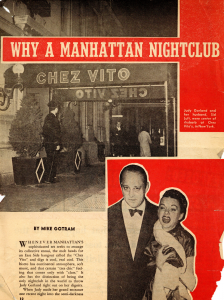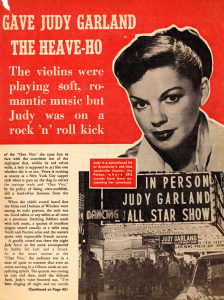This post is by Callum Blackmore, a GSAS student and intern in the RBML’s Graduate Student Internship in Primary Sources.
Two recently processed collections at the Rare Book and Manuscript Library provide insights into the life and work of Judy Garland. But while one paints the star in a largely negative light, the other offers a rare look into her musical renaissance.
Part I: The Queen of the Comebacks
“I’m the queen of the comebacks,” Judy Garland once told an interviewer.[1] And, indeed, despite severe setbacks, Garland was always intent on reinventing her career – on finding new audiences, trying new mediums, and forging new artistic identities. A 1951 “comeback” saw Garland reinvent herself as a concert performer; a 1954 “comeback” saw her return to the silver screen in A Star Is Born. However, she achieved her most famous “comeback” in the early 1960s. After a near fatal brush with meningitis, Garland sought to revitalize her concert career, embarking on an ambitious slate of performances and residencies which culminated in a high-profile concert in Carnegie Hall concert in 1961. Dubbed the “Greatest Night in Show Business History,” the sold-out concert was marked by its glitzy audience of celebrities (reportedly including Rock Hudson, Ethel Merman, Lauren Bacall, Debbie Reynolds, Harold Arlen, Bob Fosse, Richard Burton, Henry Fonda, Anthony Perkins, Julie Andrews, and Carol Channing) and by the presence of Capitol Records, who recorded the concert for commercial release.[2] Attendees remarked on the electric, almost feverish atmosphere, so palpably captured on the Capitol LP. (“The cultists were beside themselves. What Rev. Billy Graham would have given for such a welcome from the faithful!,” wrote the New York Times correspondent.[3]) The live recording catapulted Judy Garland back into the global spotlight, single-handedly reinvigorating her ailing career: it spent 13 weeks at the top of the Billboard charts (and didn’t leave the charts for 95 weeks), nabbing five Grammy awards. [4] Judy Garland became the first woman in history to win a Grammy for album of the year.
Onstage with Garland that night was an up-and-coming musician named Mort Lindsey. A songwriter by trade, Lindsey broke into show business as a studio pianist and bandleader for NBC. He was about to take a year off from performing to focus on his compositional career when he received a call from one of Judy Garland’s managers in 1961 asking him to conduct her orchestra for a concert in the Catskills. The previous bandleader had allegedly struggled to wrangle Garland’s difficult arrangements and had dropped out at the last minute, leaving a sudden, urgent vacancy.[5] “We sort of got him on a fluke, actually,” Garland once said:
“He wasn’t going to conduct anymore. He wanted to write. So we finagled him to come to the rehearsal and he rehearsed the whole show with the band and I don’t think it took him any longer than two hours […]. I think he’s absolutely marvelous!”[6]
From this chance encounter blossomed a vibrant collaboration between Garland and Lindsey which continued, in various guises, until Garland’s death seven years later. Lindsey provided the musical architecture for Garland’s 1961 comeback, working primarily as an arranger, conductor, and pianist. He would arrange the 22 songs on Garland’s Carnegie Hall setlist, conducting her 40-piece orchestra.
This fateful meeting would change the course of both of their careers. Lindsey, about to give up a life on stage and on air to launch his songwriting career, instead found an eclectic career as an arranger through his work with Garland. Lindsey, meanwhile, offered Garland a new degree of artistic independence as she sought to restore the kind of musical agency that she had lost under the studio system. Lindsey’s arrangements were bespoke for Garland – an expression of her own aesthetic identity, tailored exactly to her specifications. Through these songs, Garland triumphantly asserted her newfound autonomy: she eschewed the theatrical trappings of her vaudeville and Hollywood beginnings for something more raw, more personal, more Judy.[7] By Lindsey’s account, Garland was daring and assertive in her musical preferences during this career renaissance, unapologetic in her artistic decision-making: “Listen you motherf*cker,” she once told a producer: “This is my night […]. I’m going to get it the way I want it.”[8]
The Mort Lindsey scores and papers (MS#1713) were donated to the Columbia University Rare Book and Manuscript Library in 2014. They vividly capture, through sheet music and administrative documents, this exciting renaissance in Judy Garland’s career. The scores, in particular, provide a scintillating insight into Garland’s musical self-fashioning, evincing the distinctive aesthetic sensibility which emerged after Garland’s break with MGM.
While the Mort Lindsey scores and papers capture a high point in Judy Garland’s life, other collections in the RBML show the singer at her lowest. Leyna Gabriele – a singer and restaurateur whose papers are also held at Columbia – recalled that Garland was “quite drunk” when she and her then ex-husband Sid Luft came to her Upper East Side restaurant, Chez Vito, in 1957.[9] The incident, hot on the heels of Garland’s devastating Oscar snub, was widely covered in the gossip columns: a four-page spread in Hush-Hush magazine (titled “Why a Manhattan Nightclub Gave Garland the Heave-Ho”) detailed the incident. Gabriele was known for serenading Chez Vito’s guests with Neapolitan songs and operatic arias, strolling from table to table with a band of roving violinists. Garland was unimpressed by this performance. She interrupted Gabriele multiple times with cries of: “I’ve been singing all night and my tonsils need wetting!” and “Stop those damn fiddles! I can’t hear a thing with all this racket!”[10] The manager, Gabriele’s husband Vito Pisa (who famously denounced any music that didn’t “lend itself to a violin arrangement”), promptly ejected Garland and her party to cheers from other diners.[11]


The columnist partly attributes this snafu to the restaurant’s “policy of being ultra-snobbish,” but also hints at something much darker. The article brazenly speculates that Garland might be a “schizophrenic,” returning again and again to the star’s ongoing mental health problems. It paints Garland as a wild, untamable force, apparently in need of masculine control: “It all happened when Sid was with her. If he can’t control her, no one can”; “Maybe by now Sid Luft has Judy in control again.”[12] In the coverage of the Chez Vito incident – preserved in the RBML’s Leyna Gabriele papers– one senses the immense stigma that Garland faced both as an outspoken woman in show business, but also as a prominent figure whose mental health struggles were painfully public. The notion of “control” brokered by gossip columnists is bitterly ironic, for so many of Garland’s troubles stemmed from the “control” that men asserted over her voice, body, and actions. From the managers who embezzled her money to the studio executives who forced her to starve herself, Garland’s life was nothing but layers upon layers of “control,” exercised upon her as a means of financial and aesthetic exploitation.
The image of Garland that emerges in the Leyna Gabriele papers – as a dangerously unstable drunk – could not contrast more with Mort Lindsey’s warm recollections of the singer as a thoughtful, impassioned professional with a clear musical vision. (“I’ve been with her for two and a half years, including 40 concerts, two movies, and two TV specials and we’ve never even had an argument,” he once told a friend.)[13] The discrepancy between these two collections might encourage us to think in new ways about Garland’s aesthetic agency, to reconsider her “comebacks” not merely as cynical ploys to recuperate her public image, but as genuine attempts to regain control over her own musical identity. Central to the question of agency and reinvention is the question of musical arrangement – the ways in which Garland repurposed songs to her own artistic ends. In this sense, Lindsey’s arrangements are central to understanding Garland’s musical self-fashioning, evidencing the ways in which Garland projected her own artistic sensibility on the songs that she sang.
***
Part II, a musicological deep dive on Garland and Lindsey’s collaboration, will be published on Monday at 9 a.m. Stay tuned!
[1] Quoted in Randy L. Schmidt, Judy Garland on Judy Garland: Interviews and Encounters (Chicago: Chicago Review Press, 2009), 411.
[2] Manuel Betancourt, Judy Garland’s Judy at Carnegie Hall (London: Bloomsbury, 2020), 1.
[3] Lewis Funke, “Judy Garland in Concert Attracts Cheering Fans to Carnegie Hall,” New York Times, 1961 April 24, 36.
[4] Bertrand Tessier, Judy Garland: Splendor and Downfall of a Legend, translated by Lawrence Schulman (Paris: L’archipel, 2019).
[5] “The orchestra sounds horrible: Judy’s gonna have a fit,” the producers allegedly told Lindsey during this phone conversation. See: Interview with Mort Lindsey, “Remembering Judy Garland,” Larry King Live, 2001.
[6] Quoted in Randy L. Schmidt, Judy Garland on Judy Garland: Interviews and Encounters (Chicago: Chicago Review Press, 2009), 297.
[7] Betancourt, Judy Garland’s Judy at Carnegie Hall, 31.
[8] Judy Garland, quoted by Mort Lindsey in James Kaplan, “Over the Rainbow and Then Some,” Vanity Fair, May 2011.
[9] Leyna Gabriele, My Life and Music: From Chez Vito to Baby Doe (Budapest: Fukete K Productions, 2016), 199 in the Leyna Gabriele Papers, box 20, folder 1, Rare Book and Manuscript Library, Columbia University Library.
[10] Mike Gotram, “Why a Manhattan Nightclub Gave Garland the Heave-Ho,” Hush-Hush, 1957, clipping in the Leyna Gabriele Papers, box 6, folder 6, Rare Book and Manuscript Library, Columbia University Library.
[11] Sandi Dinkins, “Vito Pisa Explains Taste in Music,” Daily American, 1960 February 21-22, clipping in the Leyna Gabriele Papers, box 6, folder 6, Rare Book and Manuscript Library, Columbia University Library.
[12] Gotram, “Why a Manhattan Nightclub Gave Garland the Heave-Ho.”
[13] Quoted in Tom Mackin, Brief Encounters: From Einstein to Elvis (Bloomington: Authorhouse, 2008), 19. Lindsey also offers positive recollections of his work with Garland in the Mort Lindsey scores and papers, box 4, folder 3, Rare Book and Manuscript Library, Columbia University Library. Lindsey would eventually work with Garland on over a hundred concerts and three movies.